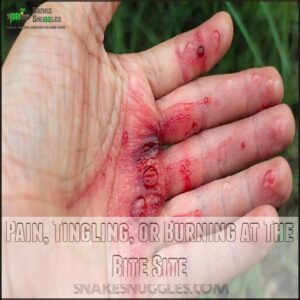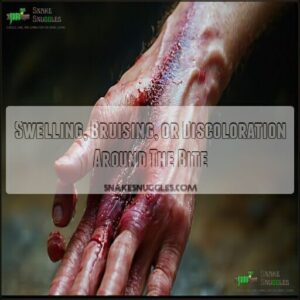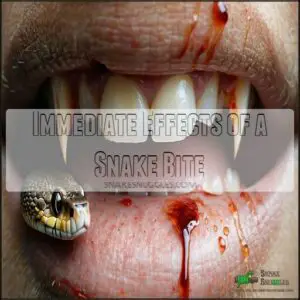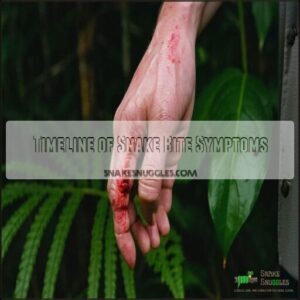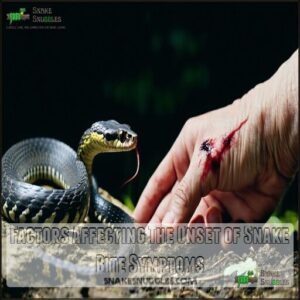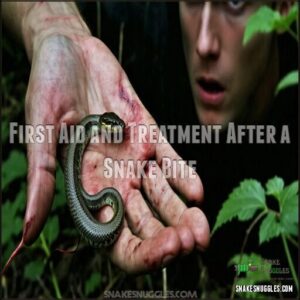This site is supported by our readers. We may earn a commission, at no cost to you, if you purchase through links.
 You’ll feel the effects of a snake bite surprisingly quickly – often within 5-30 minutes for most venomous species.
You’ll feel the effects of a snake bite surprisingly quickly – often within 5-30 minutes for most venomous species.
Pain and swelling usually appear first at the bite site, followed by spreading numbness or tingling.
Some bites, like coral snakes, might delay symptoms for hours, giving a false sense of security.
The clock starts ticking immediately, though factors like the snake species, venom amount, and where you’re bitten affect how quickly symptoms develop.
Your body size and health condition also influence reaction time.
Understanding the critical first-hour window can make all the difference in effective treatment.
Table Of Contents
- Key Takeaways
- Recognizing Snake Bite Symptoms
- When Do Symptoms of a Snake Bite Appear
- Immediate Effects of a Snake Bite
- Timeline of Snake Bite Symptoms
- Factors Affecting The Onset of Snake Bite Symptoms
- First Aid and Treatment After a Snake Bite
- Frequently Asked Questions (FAQs)
- How long does it take for a snake bite to affect you?
- What happens after 1 hour of snake bite?
- What is the 20 minute test for snake bite?
- How long does it take to feel a snake bite?
- How long does it take for rabies to manifest in humans after a bite?
- How long does it take to recover from a snake bite?
- What happens if you get bitten by a snake?
- How long does it take to die from a snake bite?
- How do you know if a snake bite is serious?
- How many hours after a snake bite will you show symptoms?
- Conclusion
Key Takeaways
- You’ll typically feel snake bite effects within 5-30 minutes, starting with pain and swelling at the bite site, followed by spreading numbness or tingling.
- Your reaction time depends on several factors: the snake species, amount of venom injected, bite location (bites closer to your heart spread venom faster), and your body size and health condition.
- You’ll notice immediate warning signs including two distinct puncture marks, a sharp burning sensation, rapid swelling, and skin discoloration around the bite area.
- You should keep the bitten limb below heart level, remove jewelry and tight clothing, stay calm to slow venom spread, and seek immediate medical attention rather than waiting for symptoms to worsen.
Recognizing Snake Bite Symptoms
You’ll notice specific warning signs within minutes to hours after a snake bite, including puncture marks, pain, and rapid swelling around the bite area.
Recognizing these symptoms quickly can save your life, as even mild initial symptoms can rapidly progress to serious complications that require immediate medical attention.
Common Signs of a Snake Bite
Recognizing a snake bite in the first moments after it occurs can save your life.
When a snake strikes, your body immediately displays specific warning signs that demand attention:
- Puncture wounds – Look for one or two distinct fang marks at the bite site
- Burning sensation – An immediate sharp, burning pain that intensifies quickly
- Rapid swelling – The area around the bite begins to swell within minutes
- Redness appearance – Skin discoloration surrounding the bite site develops fast
- Bruising development – Discoloration may appear as blood vessels are damaged
These immediate signs of a snake bite should trigger urgent action.
Applying a snake bite bandage can help slow the spread of venom.
Don’t wait for symptoms to worsen—seek emergency medical attention immediately.
Understanding these first signs gives you critical time to respond properly and potentially save a limb or life.
Pain, Tingling, or Burning at The Bite Site
When a snake’s fangs pierce your skin, pain is typically the first and most memorable symptom you’ll experience. Unlike ordinary cuts, snake bite pain has distinctive characteristics that signal danger.
Pain from a snake’s bite isn’t ordinary—it’s a sharp, burning alarm signaling venom coursing through your tissues.
Within seconds to minutes after being bitten, you’ll likely notice:
- A sharp, burning sensation radiating from the puncture marks
- Intense tingling that spreads outward along nerve pathways
- A deep, throbbing ache that intensifies rather than fades
- Unusual sensitivity in the affected area, even to light touch
Pain intensity varies substantially based on the snake species and bite location. Bites on fingers or toes—areas with concentrated nerve endings—often produce more severe pain than bites on larger body parts.
Even "dry bites" without venom injection can cause immediate discomfort, though typically less severe. The duration of tingling may extend several hours or days depending on nerve involvement. Immediate action may include sourcing necessary bite treatments to mitigate further complications.
Remember: any snake bite deserves medical attention, regardless of initial pain levels.
Swelling, Bruising, or Discoloration Around The Bite
After a venomous snake bite, visible changes appear rapidly around the puncture site.
Watch for tissue damage indicators like unusual warmth and tenderness. These signal venom spread and require immediate medical attention.
A critical first step involves using a suitable compression bandage. Don’t delay your response—quick action can prevent long-term effects of snake bite reactions.
The immediate effects of swelling may seem mild initially but can rapidly worsen.
When Do Symptoms of a Snake Bite Appear
You’ll notice the first signs of a venomous snake bite within 5-30 minutes, with pain, redness, and swelling appearing at the bite site.
Your symptoms will develop faster if the bite is closer to your heart, with highly toxic snakes like cobras causing severe effects within 30 minutes to 2 hours.
Benefits of Team Collaboration
Many medical professionals cite team collaboration as essential when treating snake bite victims.
The shared knowledge among specialists dramatically reduces venom onset time through coordinated responses.
When facing snake bite symptom onset, effective teams deliver better outcomes through:
- Faster problem-solving that cuts critical minutes off treatment time
- Increased innovation in approaching complex envenomation cases
- Efficient skill development through real-time knowledge transfer
- Higher morale boost that enhances focus during high-pressure situations
- Better distribution of tasks based on individual expertise
Businesses see improvements when they promote collaboration effectively.
Understanding how fast venom acts is essential, but equally important is the team’s cohesive response that transforms snake bite reaction time into successful treatment, highlighting the value of effective teams and coordinated responses in medical emergencies.
Challenges in Teamwork Dynamics
While teamwork is valuable during emergencies, several challenges can hamper snake bite response efforts.
Communication barriers between medical professionals and local healers often delay vital treatment decisions. Conflicting personalities and leadership styles create tension when minutes matter most. Unequal workloads leave some responders overwhelmed while others remain underutilized.
Lack of trust between team members substantially impacts treatment speed:
Challenge
Impact on Response
————-
Communication breakdown
Goal misalignment
Unequal contribution
Effective teamwork guarantees faster care when snake bite symptoms appear, potentially saving lives.
Strategies for Effective Communication
Effective communication serves as a lifeline when tracking snake bite symptoms and coordinating emergency response.
When monitoring snake bite symptoms, implement these communication strategies:
- Active listening to the victim’s description of pain, tingling, or swelling
- Clear messaging about the timeline and speed of onset of symptoms
- Recognition of nonverbal cues indicating worsening immediate signs
- Conflict resolution to keep everyone calm during the emergency
- Empathy building to reassure the victim while awaiting medical help
Don’t hesitate to overcommunicate when every minute counts.
Remember to remove any constricting items, as detailed in snake bite first aid.
Clear communication guarantees faster treatment decisions and better outcomes during this critical medical emergency.
Immediate Effects of a Snake Bite
You’ll feel the effects of a venomous snake bite surprisingly quickly, with sharp pain, redness, and puncture marks appearing within 5-30 minutes of being bitten.
Swelling begins almost immediately at the bite site and spreads outward, often accompanied by a burning sensation that signals venom has entered your bloodstream.
Searing Pain and Stinging Sensation
Pain from a snake bite strikes fast and hard, typically within seconds of the fangs breaking your skin.
This initial sharp stinging rapidly intensifies into a severe burning sensation as venom spreads through your tissues.
Most victims describe the pain intensity in three distinct phases:
- Immediate sharp prick – similar to a needle injection but quickly intensifying
- Spreading burn – a sensation like acid flowing through your veins, expanding outward
- Deep, throbbing ache – persistent pain that can last hours or days
The burning timeline varies based on the snake species and venom amount injected.
Bite discomfort often feels worst on extremities with concentrated nerve involvement, such as fingers or toes.
Even "dry bites" without venom can cause significant pain due to tissue damage from the fangs.
Remember that intense pain doesn’t always indicate venom – some highly venomous snakes produce relatively mild initial sensations despite serious danger.
Two Puncture Wounds and Redness
The telltale signature of a venomous snake bite appears instantly as two distinct puncture wounds about half an inch apart.
You’ll notice these fang marks accompanied by surrounding redness that develops within minutes after being bitten. Unlike non-venomous snake scratches, these puncture marks serve as critical venomous indicators during your initial assessment.
The redness extent typically spreads outward from the bite site, along with a noticeable warmth sensation. For proper bite differentiation, remember that pain intensifies as the redness expands, usually within 5-15 minutes post-bite.
This increasing discomfort directly correlates with fang mark severity and helps medical professionals evaluate the situation. Remember to perform snake bite first aid immediately after the incident.
Swelling at The Bite Site
Within minutes of a snake bite, swelling emerges as one of the earliest visible signs of envenomation. This localized reaction typically begins at the bite site and gradually spreads outward as venom disperses through surrounding tissues.
Swelling speaks first—a visible alarm that venom has begun its silent invasion through surrounding tissues.
- Swelling severity depends on venom volume and potency, with pit vipers causing more dramatic swelling
- Complete swelling can develop within 2-3 hours, peaking at 24-48 hours post-bite
- Measuring the circumference of your affected limb helps track progression
- Without treatment, swelling may persist for 3-7 days, potentially causing permanent tissue damage
The swelling timeline varies based on bite location—limbs with better circulation swell faster than areas with fatty tissue. Your age, size, and health also influence swelling onset and intensity. Remember that even mild initial swelling can rapidly worsen, making immediate medical attention imperative.
Timeline of Snake Bite Symptoms
You’ll notice the effects of a snake bite at different times depending on the snake type and venom potency.
Symptoms typically begin within minutes with pain and swelling near the bite, while more serious effects like breathing problems or neurological symptoms may develop within one to six hours.
Symptoms Within The First Hour
Venomous snake bites trigger a cascade of symptoms that unfold rapidly within the first hour.
The initial pain begins almost immediately after the puncture marks appear, often described as a sharp, burning sensation at the bite site.
Within 5-15 minutes, you’ll notice rapid swelling and redness developing around the wound.
This swelling typically spreads outward as the venom circulates.
By the 30-minute mark, more concerning systemic reactions may emerge: nausea, dizziness, and weakness can make you feel suddenly ill.
Your heart rate might increase, and you might experience sweating or chills.
For bites from highly venomous species like rattlesnakes, breathing difficulties and chest tightness can develop within 45-60 minutes.
Blood blisters may form at the bite site, and the surrounding tissue often shows significant discoloration.
Don’t wait for all snake bite symptoms to appear before seeking help – every minute counts when venom is involved.
Symptoms After 1 Hour of a Snake Bite
As the first hour after a snake bite passes, symptoms intensify dramatically.
The initial localized effects now give way to more serious systemic symptoms.
- Swelling and discoloration spread further from the bite site, showing progressive venom spread
- Nausea, vomiting, and dizziness typically emerge between 30 minutes to 2 hours
- Breathing difficulties or swallowing problems may develop within 1-4 hours
- Severe pain intensifies as tissue damage accelerates (2-6 hours)
- Fever, chills, weakness, and confusion signal advancing cardiovascular impact
Your body’s snake bite reaction time varies based on venom type and amount injected.
Don’t wait for all symptoms to appear before seeking help—the snake bite symptoms timeline becomes increasingly critical with each passing minute.
Medical intervention can prevent life-threatening neurological effects, even if initial symptoms seemed mild.
Factors Affecting The Onset of Snake Bite Symptoms
You’ll notice different speeds in how quickly snake bite symptoms appear, depending on factors like the snake species, amount of venom injected, and where on your body you were bitten.
Your age, size, and overall health also play important roles in how quickly you’ll feel effects, with symptoms appearing faster in children and those with existing health conditions, particularly because existing health conditions and age can significantly influence the outcome.
Type of Snake and Venom Amount
The type of snake that bites you directly impacts how quickly symptoms appear.
Different snake species produce distinct venom types with varying potency levels.
| Snake Type | Venom Type | Symptom Timeline |
|---|---|---|
| Rattlesnake | Cytotoxic | Pain within minutes, swelling in 30-60 minutes |
| Coral Snake | Neurotoxic | Delayed effects, serious symptoms in 2-12 hours |
| Cobra | Neurotoxic | Paralysis beginning in 30 minutes to 2 hours |
| Viper | Hemotoxic | Bleeding within 1-3 hours |
| Black Mamba | Neurotoxic | Life-threatening within 20 minutes |
The amount of venom injected also matters substantially.
Some bites are "dry bites" with no venom at all, while others deliver maximum venom.
Larger snakes typically inject more venom, which speeds up the onset of symptoms and increases their severity.
Certain species exhibit variable venom compositions, affecting symptom onset.
Bite Location and Individual Factors
Beyond the snake species, where you’re bitten substantially impacts symptom timing.
Torso bites and head bites are more dangerous than extremity wounds because they’re closer to essential organs and allow faster venom absorption rates.
Your individual factors matter too.
Victim size plays a pivotal role—children experience symptoms faster than adults due to smaller body mass influence.
Your health status affects how quickly symptoms appear, with pre-existing conditions potentially accelerating venom effects.
The bite location determines how quickly venom enters your bloodstream.
Remember that regardless of these factors, seeking immediate medical attention is always the right choice after any snake bite.
First Aid and Treatment After a Snake Bite
You’ll need to act quickly and correctly in the first minutes after a snake bite occurs, as proper first aid can substantially slow venom spread and improve your outcome.
Your actions during this critical window, before medical help arrives, can make the difference between a manageable recovery and life-threatening complications.
Moving Away From The Snake
After experiencing a snake bite, your first action must be moving away from the snake. While venom impact speed varies, your immediate safety prevents additional strikes.
For safe escape, follow these steps:
- Back away slowly (5-10 feet) while facing the snake, maintaining eye contact without making sudden movements that might trigger defensive behavior.
- Choose clear escape routes free from obstacles where other snakes might hide.
- If in a group, alert others calmly about the snake’s location to guarantee group safety.
Don’t worry about snake identification until you’re at a safe distance. Most snakes won’t chase humans unless cornered. Once you’ve created this buffer zone, you can focus on addressing the snake bite initial symptoms, which may appear within minutes.
Keeping The Bitten Limb Below Heart Level
After moving away from the snake, proper positioning of the bite area is your next priority.
Keep the bitten limb below heart level to slow venom spread throughout your body.
This simple action uses gravity’s role to your advantage, reducing circulation impact and giving you valuable time before reaching medical care.
Lowering the affected area helps minimize how quickly venom travels through your bloodstream.
Conversely, elevating the limb accelerates venom distribution, potentially worsening snake bite immediate effects.
For ideal positioning, pair this with limb immobilization using a splint if available.
Remember: lower position equals slower venom impact speed.
This 30-second adjustment can substantially influence your venom effect timeline while awaiting emergency treatment.
Staying Calm and Still
While properly positioning your bitten limb is vital, your next priority is to stay calm and still.
Panic increases your heart rate, which accelerates venom spreading time throughout your system.
Take slow, deep breaths to reduce panic—inhale for four counts, hold briefly, then exhale for six.
This technique helps manage both pain and promotes clear thinking when you need it most.
- Minimizing all movement prevents further injury and slows the venom effect start, giving you valuable time until medical help arrives.
Remember, staying calm doesn’t just help you—it aids bystanders by keeping the situation under control, allowing everyone to focus on proper snake bite treatment.
Removing Jewelry and Tight Clothing From The Bite Area
After a snake bite, one critical step is removing jewelry and loose clothing from the bite area. When venom enters your system, swelling develops rapidly—often within minutes.
Removing restrictive items is essential because:
- Rings, watches, and bracelets can become dangerous tourniquets as tissue swells
- Tight clothing creates circulation impairment around the bite site
- Material interference can worsen the localized reactions to venom
- Constriction risks increase with every minute these items remain in place
Act quickly by taking off all jewelry from the affected limb and loosening tight clothing near the bite. This swelling accommodation technique prevents additional complications that could worsen the situation.
"Think of your jewelry like a fence around a growing garden," explains Dr. Keller, emergency medicine specialist. "It may fit fine now, but soon it will restrict everything inside."
Remember, addressing these constriction risks is a first aid priority while seeking medical treatment.
Seeking Immediate Medical Attention if Symptoms Occur
The clock starts ticking once you’ve removed restrictive items from the bite area.
Don’t wait for symptoms to worsen – seek immediate medical attention as soon as you notice signs of envenomation.
Snake bite effects progress rapidly through your system, with symptom progression potentially accelerating within minutes.
Call emergency services right away, noting your hospital proximity and potential antivenom availability.
Emergency response time is critical, as venom spreads quickly through your bloodstream.
If possible, have someone drive you to medical care if ambulance wait times are lengthy.
Record the onset time to help healthcare providers assess your condition accurately.
Antivenom administration is most effective when given promptly, ideally within 6 hours.
Even mild snake bite symptoms can rapidly develop into serious, long-term complications.
Medical experts need to evaluate the severity and administer proper treatment before the situation escalates.
Remember: minutes matter with snake bites.
Quick medical intervention substantially improves your recovery outcomes.
Frequently Asked Questions (FAQs)
How long does it take for a snake bite to affect you?
You’ll feel venomous snake bite effects within minutes to hours.
Initial symptoms like pain and swelling appear in 5-30 minutes, while serious systemic effects may develop within 30 minutes to 2 hours after the bite.
What happens after 1 hour of snake bite?
Like a wildfire gaining momentum, your body’s under siege after an hour of snake bite.
You’ll experience intensified swelling, severe pain, possible nausea, and systemic symptoms as venom spreads through your bloodstream.
What is the 20 minute test for snake bite?
The 20-minute whole blood clotting test detects coagulopathy in snakebite victims.
You’ll need 1-2 ml of blood in a clean glass container, left undisturbed for 20 minutes, then checked for clotting.
No clot indicates venom-induced blood abnormalities.
How long does it take to feel a snake bite?
You’ll feel a snake bite immediately as a sharp, pinching sensation.
Venomous bite effects typically develop within 5-30 minutes, with pain and swelling appearing first.
Severity depends on the snake species and venom amount.
How long does it take for rabies to manifest in humans after a bite?
Rabies typically takes 20-90 days to manifest after you’re bitten.
You’ll notice symptoms within 1-3 months, though rarely it can appear in as little as 4 days or as long as several years, which can be considered a rare occurrence in the timeframe of the disease.
How long does it take to recover from a snake bite?
John’s rattlesnake bite took three weeks to heal.
You’ll recover from minor bites in 1-2 weeks, while severe envenomation may take 3-6 months.
With proper medical care, you’ll bounce back faster.
What happens if you get bitten by a snake?
You’ll experience pain and swelling at the bite site, possibly followed by nausea and dizziness.
Venomous bites can cause tissue damage, breathing problems, and even death without prompt medical attention.
Don’t panic—seek help immediately, as prompt medical attention is crucial.
How long does it take to die from a snake bite?
Death from snake bites varies widely, from 30 minutes with highly venomous species to several days with less toxic ones.
Your survival chances improve substantially with immediate medical attention and proper antivenom treatment.
How do you know if a snake bite is serious?
Look for two puncture marks with rapid swelling, intense pain, and redness. You’ll notice bruising, nausea, dizziness, or difficulty breathing if it’s serious. Seek immediate medical attention regardless of symptoms.
How many hours after a snake bite will you show symptoms?
Symptoms from venomous snake bites typically appear within 30-60 minutes, but can vary widely.
You’ll usually notice pain and swelling immediately, while systemic effects may develop within 1-8 hours depending on snake species and bite severity.
Conclusion
Like a ticking clock in a suspense movie, time is critical when dealing with snake bites.
Remember, how long it takes to feel the effects of a snake bite varies widely—from minutes to hours depending on the snake, venom amount, and your personal factors.
Don’t wait for severe symptoms to appear before seeking help, as quick recognition and proper first aid within that vital first hour could literally save your life or limb.
When in doubt, always seek medical attention immediately.


